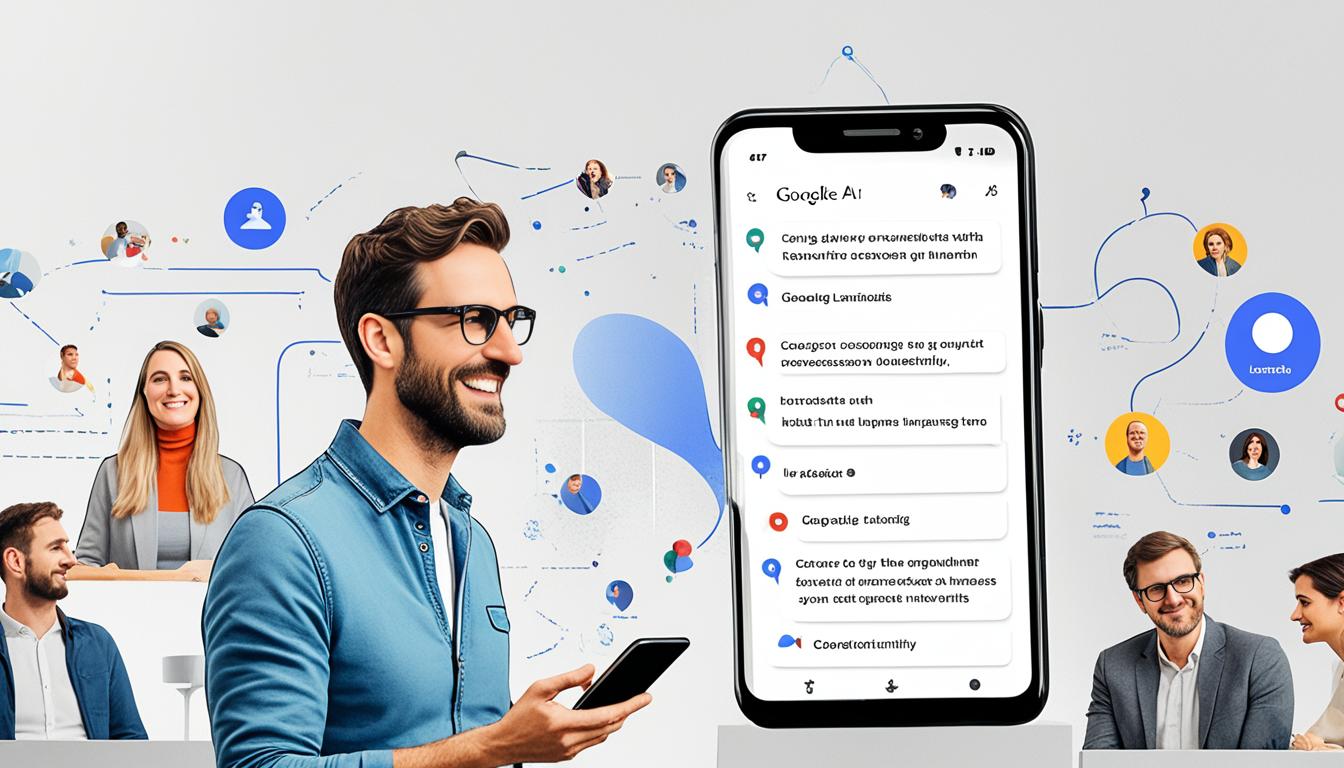“As an Amazon Associate I earn from qualifying purchases.” .
Imagine chatting with a machine that talks like a pro, making it hard to tell it’s not human. This dream is getting closer, thanks to Google’s LaMDA AI. It’s a conversational AI that’s changing how we talk to machines. Picture having a chat that feels like you’re talking to a friend, not a robot. That’s what LaMDA offers – making AI conversations feel human.
Google has always aimed to organize the world’s info for everyone. They’ve made big strides in machine learning and algorithms. LaMDA is the latest step in understanding and processing human language better. It’s not just another chatbot. LaMDA can talk about many topics, understanding human conversation like a pro. It gives answers that are not just right, but also very specific and smart.
Key Takeaways
- Discover how Google’s LaMDA AI is redefining the realm of conversational AI.
- Explore advancements in natural language processing leveraged by LaMDA.
- Understand how LaMDA differs from traditional chatbots by enabling free-form dialogue.
- Learn about LaMDA’s application in improving human-computer interaction.
- Gain insight into the ethical considerations posed by increasingly sophisticated AI technologies.
Introduction to Google’s LaMDA AI
Google’s LaMDA AI is a big step forward in artificial intelligence. It comes from Google’s deep research in transformer neural networks. The Introduction to Google LaMDA language model shows how it’s different from old chatbots. It’s all about having dynamic, context-aware dialogues.
The LaMDA AI capabilities are impressive. It can have conversations that are detailed and fit the situation. LaMDA is great at changing topics and understanding human interaction. This makes it a key player in AI chat.
LaMDA AI came from Google’s work on the Transformer project. It’s changed how machines talk in human-like conversations. This model is also the base for Google’s AI chatbot Bard. It’s expected to change how we use conversational AI in the future.
| Feature | Impact | Year Introduced |
|---|---|---|
| Conversational AI Service Bard | Testing phase; built on LaMDA | 2023 |
| Computation Scale Doubling | Exceeds Moore’s Law | Biannual |
| MUM Technology | 1000x more powerful than BERT | Recent Years |
| AI Principles Published | Commitment to responsible AI development | 2018 |
| Generative Language API | Open for developers and creators | Upcoming |
Google’s work on LaMDA AI shows their dedication to AI progress. It also points to LaMDA’s big potential in areas like education and customer service. By making complex info easy to understand, Google is changing how tech meets human creativity.
Understanding Natural Language Processing with LaMDA
AI is moving fast, and LaMDA is a big step forward in how machines understand human language. Google has been working hard to make talking to computers easier. They’ve moved from BERT to LaMDA, showing how much they’ve improved.
The Evolution of Language Understanding
LaMDA can understand trillions of words from the internet. This is a huge jump in how machines get language. It’s not just a new feature; it’s changing how computers talk to us.
From BERT to LaMDA: A Technological Leap
Going from BERT to LaMDA is a big deal in AI. BERT was great at understanding text, but LaMDA is better at talking like us. It uses the Transformer architecture to make sure its answers are right and interesting.
Google is also thinking about the ethical side of AI. They want to make sure AI doesn’t spread false information or be biased. This shows they’re serious about using AI responsibly.
LaMDA is building on what BERT and GPT-3 started. Google plans to use LaMDA in tools like Google Assistant and Google Meet. This could make AI communication better and more natural.

How Google LaMDA Language Model Transforms Conversations
The chat with LaMDA AI marks a big change in how we talk online. It’s different from old chatbots because it can have open-ended talks. This makes conversations feel more like talking to a person. Thanks to machine learning and understanding language, LaMDA can give smart and fitting answers.
| Feature | Description | Impact |
|---|---|---|
| Parameter Count | Up to 137 billion parameters | Enables sophisticated handling of diverse conversational topics |
| Training Dataset | Pre-trained on 1.56 trillion words from web texts | Extensive understanding of language nuances and dialogues |
| Scope of Application | From content creation to customer service | Improves user engagement across digital platforms |
| User Experience | Facilitates engaging conversations with AI | Enhances overall user satisfaction and interaction quality |
| Concerns and Oversight | Biases and potential for harmful content | Requires continuous monitoring and updates for fairness |
Google is changing how we talk to AI with LaMDA. It moves away from simple answers to more real and dynamic talks. Whether it’s answering customer questions, suggesting content, or just chatting, LaMDA is setting new standards for AI.
Soon, talking to machines might feel just like talking to another person. This could change how we use technology in our daily lives.
Google’s LaMDA AI: Capabilities Beyond Standard Chatbots
Standard chatbots often give us limited interaction, sticking to scripted answers. But Google’s LaMDA AI is a big step forward in advanced conversational AI. It changes how we talk to machines, making it feel more like talking to another person.
Engaging in the Nuances of Human Dialogue
Google’s LaMDA is great at understanding language model dialogue nuances. It can respond with humor and empathy, making conversations feel more natural. This AI technology can really get what we’re saying and respond in a way that feels human.
Breaking the Bounds of Predefined Conversational Paths
Google’s LaMDA AI is exciting because it can go beyond usual chatbot conversations. It uses a lot of training data to have dynamic conversations. This means it can answer open-ended questions and keep up with back-and-forth talks, just like a real person.
Here’s a look at how traditional chatbots and Google’s LaMDA AI compare in conversation:
| Feature | Traditional Chatbots | Google’s LaMDA AI |
|---|---|---|
| Response Flexibility | Limited; follows a scripted path | High; can deviate from scripts to generate novel responses |
| Understanding Context | Basic; often misinterprets complex queries | Advanced; grasps and responds to complex nuances in dialogue |
| Conversation Depth | Shallow; suitable for simple queries | Deep; can engage in intricate and sustained conversations |
| Learning Capability | Static; requires manual updates | Dynamic; continuously learns from interactions |
| Application Scope | Narrow; specific use-cases | Broad; adaptable to varied conversational needs |
Google’s LaMDA AI marks a big change in advanced conversational AI. It’s making digital chats richer and more engaging. By going beyond usual AI talks, LaMDA is setting a new bar for how tech talks to us every day.
The Development Path of LaMDA AI Technology
Google’s journey in making conversational AI better has seen big steps. These steps were led by Google Brain research. From simple ideas to complex, understanding systems, this shows how AI has grown a lot.
From Meena to LaMDA: The Journey
Google started with Project Meena, a first step in conversational AI. This project laid the groundwork for future improvements. The move from Meena to LaMDA was a big change. It came with the use of advanced Transformer neural networks. These networks help understand and create text that sounds like a human.
The Architectural Backbone: Transformer Neural Networks
LaMDA’s power comes from the Transformer neural network design. Google Brain created this design, changing how machines understand language. It uses self-attention to look at all words in a sentence together. This makes LaMDA’s answers more relevant and natural.
Here’s a look at how Google’s conversational AI models have changed:
| Feature | Meena | LaMDA |
|---|---|---|
| Development Year | 2020 | 2021 |
| Neural Network Type | Evolved Transformer | Advanced Transformer |
| Main Capability | Multi-turn Conversations | Contextual Understanding |
| Safety Features | Basic Monitoring | Enhanced Bias and Safety Testing |
| Personality Variants | Limited | Dynamic (e.g., “Happy T-Rex”) |

The move from Meena to LaMDA shows a big improvement. Transformer-based designs played a key role in this change. Each step aimed to make the model smarter and safer. This shows Google Brain’s focus on ethical AI development.
Innovative Features of Google’s LaMDA AI
Google’s LaMDA AI is a big step forward in making digital chats more natural and fun. Let’s look at what makes this tech special.
Sensibleness and Specificity in Conversations
LaMDA AI’s innovative features shine in its smart responses. It knows how to answer in a way that fits the conversation perfectly. This makes talking to it feel more personal and useful.
With 137 billion parameters, LaMDA is super smart at understanding and keeping up with chats. This boosts its conversational AI sensibleness.
Responsible AI with Google’s Ethical Framework
Google made sure LaMDA is built with ethical AI development in mind. They set rules to make sure it’s fair and doesn’t spread false info. They also check its answers to keep it safe and respectful.
Google keeps making LaMDA better by focusing on interesting and correct answers. This makes the AI more fun and useful, while sticking to ethical AI development standards.
For more details on how Google uses these ideas in real life, check out their guidelines on AI.
Applications and Uses of LaMDA AI in Today’s World
Google’s LaMDA AI is changing the game, making its way into our daily lives. It’s not just for tech experts anymore. Now, you can talk to your digital assistant in a way that feels natural. It understands what you’re saying and responds accordingly, making your life easier.

LaMDA is turning our devices into smart friends. Whether you’re setting reminders or controlling your home, LaMDA makes it all smoother. Imagine asking your smart speaker about the weather and it not only tells you but also suggests bringing an umbrella for your meeting outside. That’s the magic of LaMDA.
Here are some areas where LaMDA really stands out:
- Digital Personal Assistants: These apps and devices can now have longer, more complex chats without getting confused.
- Customer Support: Chatbots powered by LaMDA offer better customer service, making people happier and more engaged.
- E-commerce: Shopping online is easier with LaMDA, as it helps you find products, suggests what you might like, and even solves problems.
LaMDA AI is being used in many areas like finance, healthcare, and education. Banks are now offering real-time help to customers, moving away from old-school customer service. This is just the beginning.
Using LaMDA AI is easy, even for those without tech skills. It’s great for both small startups and big companies. It can make things more efficient and improve how people use technology.
In summary, LaMDA AI is set to become a key part of our tech world. Staying updated on its features means you can use AI to make your life and interactions better.
The Real-world Benefits of Implementing LaMDA AI Technology
Using LaMDA AI is more than just a tech upgrade. It’s a big step towards smarter, more interactive AI help. By adding Google’s LaMDA (Language Model for Dialogue Applications) to different areas, both businesses and users see better communication.
Enhancing User Engagement and Interaction
LaMDA AI is great at understanding and responding to human talk. It makes answers that fit the conversation well, making chats feel real and not just automated. This leads to users feeling more connected and understood than with old chatbots.
In customer support, LaMDA makes things smoother and more personal. It helps support staff guess what customers need and help them fast, making customers happier.
Paving the Way for Conversational Search and Assistance
LaMDA AI changes how we use search tools. It lets us talk to search engines in a more natural way, unlike old methods that needed specific questions.
This is really important for tools like Google Maps. LaMDA uses AI to make planning routes and finding places better. It looks at things like safety and traffic to give users the best experience possible.
| Feature | Benefits |
|---|---|
| Natural Language Understanding | Improves interaction quality by understanding and generating human-like responses. |
| Conversational Search | Enables more intuitive searching, reducing the reliance on multiple, specific queries. |
| Personalized User Experience | Customizes interactions by analyzing user data and past behaviors, enhancing satisfaction and engagement. |
| Integration in Various Industries | Extends benefits across sectors including e-commerce, healthcare, and customer support, adapting to specific industry needs. |
By using LaMDA AI, companies can work better and make things more fun and useful for users. These AI tools are not just helpers; they’re partners in making our daily lives smarter and more responsive.
Potential and Ethical Considerations of LaMDA AI Applications
As we use AI more in our lives, we talk more about AI ethical considerations and the AI sentience debate. This is especially true for chatbots like Google’s LaMDA. It’s crucial to make sure these systems are transparent and safe AI technologies. This is key for people to trust and use them in real life.
Addressing Concerns Over AI Sentience and Bias
Google engineer Blake Lemoine sparked a big debate when he said LaMDA might be sentient. Many disagree, but it made people think more about AI’s feelings. It brings up big questions about how to use these technologies right and avoid biases. This is a big part of making transparent and safe AI technologies.
LaMDA’s design, with up to 137 billion trainable parameters, is very advanced. It can talk like a human. But, we need to think deeply about the ethics of this. Professor Lawrence Solum talked about AI personhood back in 1992, and his ideas are still important today.
Fostering Transparency and Safety in AI Conversational Models
Being clear about what AI tools like LaMDA can and can’t do is key. Laws like Toby Walsh’s Turing’s red flag law help protect users. They make sure AI tells people it’s not human at the start.
These rules help avoid the risks that experts like Meg Mitchell see with big language models. They follow the same rules as in medicine and environmental policy. This ensures AI doesn’t unfairly change how humans interact or make decisions. It’s important for making sure AI is used right in society.
| Feature | Description | Ethical Relevance |
|---|---|---|
| Training parameters | Up to 137 billion in LaMDA | Higher complexity may raise the AI sentience debate |
| Turing Test | Assess if AI can mimic human thought | Central in assessing AI consciousness and its implications |
| Shibboleth Rule | AI must identify itself clearly | Enhances transparency and user trust in AI technologies |
In conclusion, AI like LaMDA offers big chances to improve how we talk online. But, we must talk about AI ethical considerations to make sure we use it right. By focusing on safety and transparency, we can make AI a better part of our lives.
Conclusion
LaMDA AI has shown us how close we are to making talking to machines feel natural. Google’s work on LaMDA is leading us to a future where we value ethical AI as much as the tech itself. The story of Blake Lemoine shows how complex and emotional AI can make us feel.
Despite debates about whether AI can truly feel, Google is focusing on making LaMDA fair and ethical. They aim to remove biases and ensure it’s used right.
LaMDA AI is a big step forward in how we talk to computers. But the story of Lemoine reminds us to always watch over AI and talk about its place in our world. We need to think carefully about how to use this tech and what it means to us.
How we use these technologies helps shape the future and the talks around them. As we move forward, let’s make sure we’re making choices that add to our world, not take away. LaMDA AI is still growing, and we can help guide it to be a positive force in our lives.
FAQ
What is Google’s LaMDA AI?
How does LaMDA AI differ from traditional chatbots?
How has Natural Language Processing evolved with LaMDA?
What are some of the innovative features of Google’s LaMDA AI?
In what ways can LaMDA AI be applied in today’s world?
What are the real-world benefits of implementing LaMDA AI technology?
What potential and ethical considerations are associated with LaMDA AI applications?
How is Google ensuring that LaMDA AI is ethically developed?
What does the future of conversational AI look like with advancements like LaMDA?
How will LaMDA AI transform the future of customer service?
“As an Amazon Associate I earn from qualifying purchases.” .



